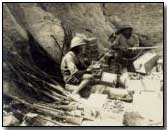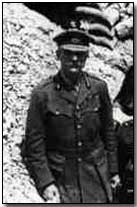Battles - The Battle of Gully Ravine, 1915
 By late June 1915 agreement
had been reached between the government in London, in the form of war
minister Lord
Kitchener, and the Mediterranean Expeditionary Force Commander-in-Chief,
Sir Ian Hamilton,
to despatch sizeable reinforcements to the
Gallipoli peninsular
to facilitate a renewed offensive in August in the north.
By late June 1915 agreement
had been reached between the government in London, in the form of war
minister Lord
Kitchener, and the Mediterranean Expeditionary Force Commander-in-Chief,
Sir Ian Hamilton,
to despatch sizeable reinforcements to the
Gallipoli peninsular
to facilitate a renewed offensive in August in the north.
In the interim however Hamilton had been instructed by Kitchener to continue to press against the Turks. During the space of June and July therefore a series of attacks were mounted from Helles on the southern tip of the peninsula. Prominent among these was the Battle of Gully Ravine, fought on 28 June 1914 along the Aegean spine of the peninsula in the wake of a moderate French success a week earlier.
The newly appointed commander of the British 29th Division, Major-General Henry de Beauvoir de Lisle, proposed a limited objective attack - in accordance with Hamilton's strict enjoinder that no sweeping breakthrough be henceforth attempted - along the Gully Ravine Spur.
In this 29 Division would receive support from two other brigades, the Indian 29th and 156th Brigade of 52nd (Lowland) Division. Artillery support was to be fairly weak - 77 guns and howitzers: a third of what might ordinarily be expected - but was the best that could be managed given ongoing artillery and ammunition shortages (a mere 12,000 rounds were allocated for the attack).
 Plans
for the attack were approved by Helles VIII Corps commander
Aylmer
Hunter-Weston, who remained hopeful that the prominent hill feature Achi
Baba could be seized, and the attack duly began with the usual
preliminary
bombardment on 28 June.
Plans
for the attack were approved by Helles VIII Corps commander
Aylmer
Hunter-Weston, who remained hopeful that the prominent hill feature Achi
Baba could be seized, and the attack duly began with the usual
preliminary
bombardment on 28 June.
Progress was initially encouraging as 87th Brigade seized the first two lines of Turkish trenches with light losses, with 86th Brigade continuing successfully to the next two trench lines. Meanwhile the 29th Brigade - with offshore naval artillery support - successfully seized Turkish coastal trenches reaching up to Fusilier Bluff.
Unfortunately for Hunter-Weston the attack conducted by 156th Brigade, newly-arrived in the sector, went badly. Although they quickly reached Turkish trench lines without effective artillery support, they were subsequently thrown back by the Turks at heavy cost, which included the loss of their commander Scott-Moncrieffe.
Determined Turk counter-strikes progressively restored to Turkish control trenches seized by the Allies on the Gully Ravine Spur, albeit at even heavier cost. Thus while the Allies had gained perhaps a kilometre along the coast, gains elsewhere were negligible.
After a week's worth of fighting losses on both sides were notable. The British counted some 3,800 casualties and their Turkish opponents as many as 14,000.
To view maps detailing the progress of the Gallipoli campaign click here; and here; and here; and here.
Photographs courtesy of Photos of the Great War website
"Harry Tate" was the nickname given by British pilots to the R.E.8 aircraft
- Did you know?
